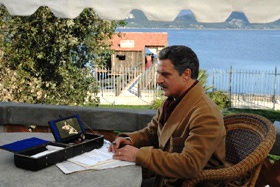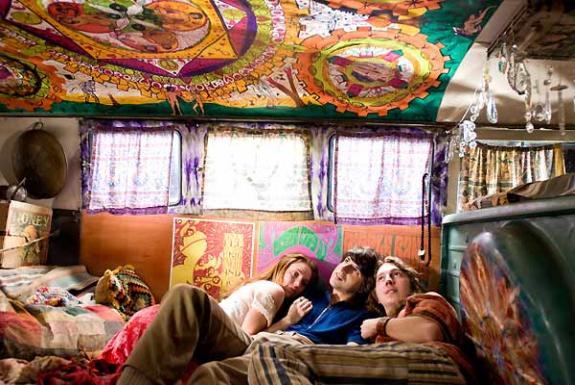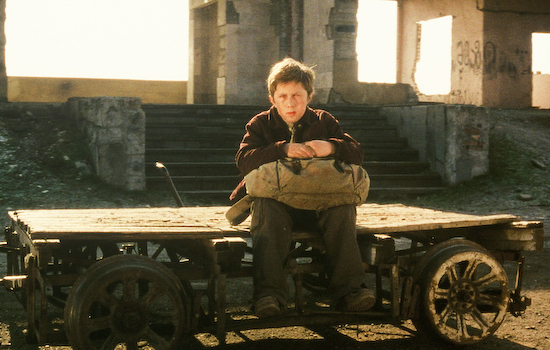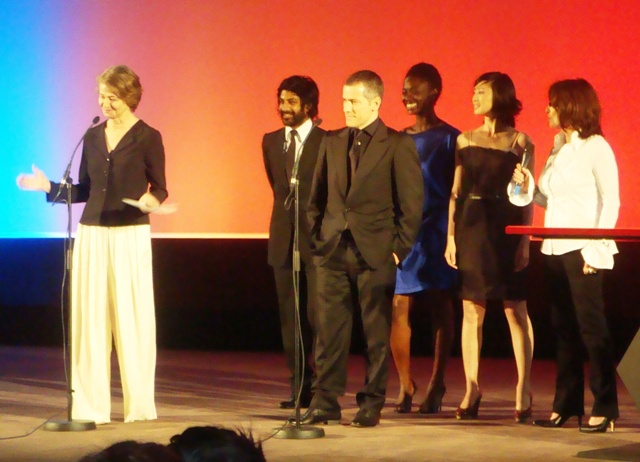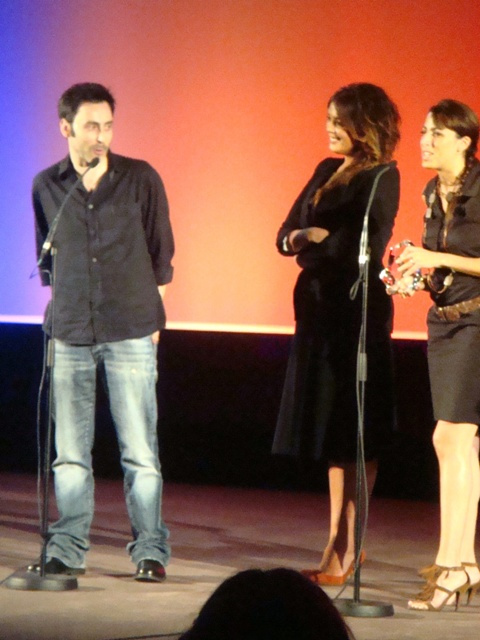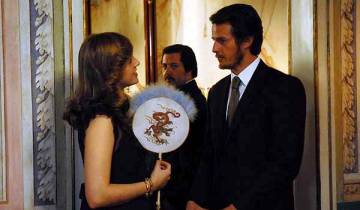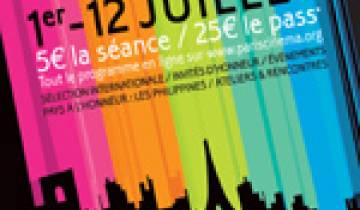Paris Cinema Festival 2009
From the 2 to the 14 of July of 2009
Edition 7
Between July 2 and 14, fifteen Parisian theaters opened their doors to film lovers, to introduce them to new talent thanks to the International Short and Feature Film Competition, the latest productions by already established directors that the festival is exhibiting in a preview in the presence of the film crews, the masterpieces of cinema history, the guests of honour, the tributes, the special cycles for the youngest and the country chosen each year to highlight its filmography.
In this 7th edition, 12 feature films from countries as diverse as Kazakhstan, Chile, Italy, the Netherlands and South Korea were presented in competition, as well as 17 short films from Malaysia, Poland, Taiwan, Mexico and Argentina, among others.
Tribute was paid to the Italian actress Claudia Cardinale, the French actor Jean-Pierre Léaud and the director Tsaï Ming-Liang, through retrospectives (the full one in the case of the Taiwanese director).
After the Philippines, this year Turkey has been honored through a panorama of some 30 films and multiple meetings with new talents from that country.
Among the films in competition we highlight The Other Bank by George Ovashvili (Kazakstan, 2009), Calimucho by Eugenie Jansen (The Netherlands, 2008) and Puccini et la fanciulla (Italy, 2008).
Chronicle of a conflict
After the fall of the Soviet Union, an unresolved conflict broke out in 1988 between Russia and Georgia over the province of Abkhazia. The greatest tragedy of this conflict is that the Georgians and the Abkhazians have the same roots, but hatred has turned them into bitter enemies. The story of The Other Bank ("The other bank") takes place a decade later, towards the end of the '90s, under the gaze of Tedo, a child who was born with the conflict and who is part of what the director Ovashvili calls "the children of war", a generation that lost everything, their family, their land, their future, living adrift in a constant state of defenselessness. In this sense, the dream told by Tedo's friend (and which is updated in images towards the end) about a jungle landscape in which zebras and giraffes are at the mercy of lions, and the duckling of plastic that the little boy recovers from the rubble into which he turned his old house. The broken toy is a metaphor for lost childhood, and the jungle, without law or any protection from the State, is a no man's land where only the strongest survive.
An epic and tragic poem at the same time, in which the hero is a twelve-year-old boy through whose eyes we see to what extreme of dehumanization the banality of violence and the rooting of hatred can lead.
Far from the wars, but close to more intimate conflicts, is Calimucho, a kind of "behind the scenes" of the traveling circus Harlekino, the revelation of the face hidden behind the mask of the always smiling clown. The circus is shown as a marginal world of nomadic beings, uprooted, who are unable to establish lasting ties neither with the land they live in nor with their closest beings.
Although the Harlekino company exists and works in the Netherlands (the film is set on the border between the Netherlands and Germany), and the script is based on the notes of a months-long trip that a journalist made with them, the story itself itself is not real. To achieve maximum naturalness, director Jansen has given the actors a great deal of freedom, leaving unedited spontaneous situations not foreseen in the script, such as that of the llama listening attentively to the prayers of the seasonal employees from the Maghreb. In some aspects, it was worked like a documentary, it was filmed with a single camera without repeating shots, then the editing was done to eliminate the superfluous or that which did not fit the plot.
The actors are not professionals, they are part of the circus staff who have been trained to play the role of themselves in circumstances different from their real lives.
"The circus is a microcosm where the whole of Europe is represented according to its social structure," said Jansen in his talk with the audience after the screening. Indeed, the owners of the circus are Dutch, but a group of Germans who refuse to help Dick are also part of the company, when his partner Willy returns drunk in the middle of the performance. Towards the end, these same Germans lead the line of caravans heading elsewhere.
We also find the aforementioned North Africans like Tarek, whom Dick, the owner's daughter, constantly asks for the papers that enable him to work and who finally leaves the circus because he feels mistreated by his bosses. But we also find that Willy's mother, a French-speaking Belgian woman, arrives at the place only in order to install discord in the couple, alleging that her grandson Timo is not leading a normal life for a child his age, after which Dick he accuses Willy of being weak for blindly obeying his mother. In this way, the domestic conflicts in Calimucho acquire political significance at a continental level.
For the film Puccini et la fanciulla, Paolo Benvenuti and Paola Baroni base themselves on a series of recently discovered letters and on a silent, sepia-colored short film dating from 1915, where Giacomo Puccini is recorded in his Torre del Lago mansion.
The bucolic beauty of the landscape inspires the master in the composition of his opera "La Fanciulla del West", but this stillness is disturbed by a dark episode: one of his domestic servants, Doria Manfredi, commits suicide after being accused by Elvira, the woman of the composer, to maintain a secret relationship with him.
The film is very far from the realistic aesthetic choices so dear to the biographical and documentary genre. There is an aesthetic position here that places special emphasis on the visual and sound aspects, highlighting them, embellishing them, poetizing them. There is no dialogue, everything is played out through noises and music, while the card reading was recorded entirely off-screen. To a large extent it is a tribute to silent cinema but it was also thought of as a form of experimentation on operatic language.
Paola Baroni recalls that the natural sounds of the lake were recorded from various angles to give them a greater depth that would allow the viewer to immerse themselves in the atmosphere of the Tuscany region. For his part, Paolo Benvenuti highlighted, in dialogue with the public, that for photography he was inspired by the macchiaioli (stainers), a pictorial movement that developed in Florence in the second half of the XNUMXth century, and that, like the French Impressionism, associated the representation of nature with spots of light and color, always developing his work in rural areas.
Previews and closing film
Singularities of a blonde girl by Manoel de Oliveira (France, Spain, Portugal, 2009).
Narrated in the first person through successive flashbacks, this film adaptation of the work of the same name written by the Portuguese novelist Eça de Queirós is a subtle and intimate oil painting of the XNUMXth-century Lusitanian bourgeois families, transferred by the magic of cinema to contemporary society.
Macario, both protagonist and intradiegetic narrator, works as an accountant in the company that his uncle owns in Lisbon. Every day he looks through the window at his attractive neighbor, a twentysomething with long blonde hair named Luisa Vilaça, who lives with her mother in the building across the street. After a while, Macario falls madly in love with her.
What at first seems like a simple romantic story ends up becoming a succession of tricks and scams that drive Macario to take a long vacation in the Algarve.
Eça de Queirós was one of the most important Portuguese novelists of the XNUMXth century. Adversary of Romanticism, he introduced in Portugal the realist movement that by then was already developing in France. In fact, many present him as the Balzac or the Portuguese Flaubert.
Ideologically close to anarchism, Eça de Queirós portrayed with extreme irony the vices and hypocrisy of the Portuguese petty bourgeoisie, his character being Macario, the naïve romantic who became an easy prey for fraudsters and careerists.
Although the novel is set in the 1811th century, Oliveira has transferred the staging to contemporary Lisbon, thus updating the conflict. The light, the colors, some planes, however, are inspired by romantic and realistic painting, especially in the Majas on the Balcony (1869) by Francisco de Goya and in The Balcony (1) by Édouard Manet, a great admirer of the Spanish artist. Subject matter aside, both paintings resemble one another in the strong lighting contrast between foreground and background, the latter being a hidden, murky, shadowy aspect of the former. In Oliveira's film, Luisa is shown leaning on the window railing in the foreground. Her white face and blonde hair appear well lit, and her game of seduction translates into a game of hiding and revealing her face using a Chinese fan in which, conspicuously, we can see the stamped image of a dragon (XNUMX). Luisa's mother, a more mature woman with dark hair, passes like a shadow in the background of the scene in the manner of a puppeteer manipulating the strings of her marionette.
Liverpool by Lisandro Alonso (France, Argentina, Netherlands, 2008)
A sailor for 20 years, Farrel asks the captain of the freighter he works for permission to go ashore and visit his terminally ill mother. Arriving in his town, he discovers that his family has a new member whom he did not know.
As in all of Lisandro Alonso's films (La libertad, 2001; Los muertos, 2004; Fantasma, 2006), long sequence shots prevail with contemplative rather than narrative purposes. Hence, his language is remarkably close to that of the post-war avant-gardes, as is the case of Italian neorealism.
G. Deleuze writes in this regard in The Time-Image, "what defines neorealism is this rise of purely optical situations (...) fundamentally different from the sensory-motor situations of the action-image in ancient realism." In this context, it is no longer the spectator who acquires a posture of passive observation in the face of the action, but the character "rather than reacting, he registers. Rather than committing himself to an action, he abandons himself to a vision (...) the situation in he finds overflows everywhere his motor capacity."(2)
Farrel seems to act and react to a given situation, however that long pilgrimage through the snowy landscapes of Tierra del Fuego, those anodyne dialogues in which silence prevails over words, that open, suspended ending, makes us think that the action-reaction situations in which the characters operate on the environment with a precise and determined purpose to provoke a change in the given situation, so present in classic cinema, is not part of Lisandro Alonso's narrative search. Hence, the viewer always has the feeling that "nothing happens" in his films.
But there is also something else in Alonso's cinema, and it is the almost mystical relationship that his characters establish with the natural environment that surrounds them. There the human figure is dwarfed, even disappearing from the frame while the landscape remains empty for a time, as if it were the true protagonist of the film. The empty, cold, dark environment of Liverpool does nothing more than aesthetically reflect the desolation and abandonment of Farrell and his family.
Taking Woodstock by Ang Lee (USA, 2009)
The year is 1969, shortly before the arrival of man on the Moon and in the midst of the Vietnam War. Elliott Tiber is going through a bad financial time and must return to live with his parents in White Lake, a town in upstate New York. He tries to save the Tibers' motel from financial ruin and finds an opportunity when the neighboring town of Katskill refuses to host the thousands of fans of the most famous hippie music festival: Woodstock. With a simple phone call, Elliott causes 500 people to flock to White Lake three weeks later, changing the lives of his family, his town and his own.
Instead of showing the great story of Woodstock, Ang Lee chose to focus on a teenager in search of his own identity, in the process leading to the discovery of his homosexuality and the struggle to achieve his independence from an oppressive family environment.
Opening with a close-up of a field of lilac flowers and a split-screen montage, so dear to American experimental cinema of the '60s, the American director of Taiwanese origin immerses us in the effervescence of an entire era in which young they dreamed of a world of peace and love.
The scene filmed with a subjective camera, in which we see, together with Elliott -who has just consumed a dose of LCD- the multicolored drawings of the caravan move in space as if they were living beings, turns out to be an effective method of immersion achieved thanks to modern digital animation techniques.
In Taking Woodstock the viewer finds a brilliant, dynamic, well-acted, filmed and post-produced comedy, funny and profound at the same time, a precious gem that dazzles by its simplicity without great pretensions.
The winners
During the award ceremony that took place at the MK2 Bibliothèque on Monday, July 13, 2009, the jury of the 7th edition of the Paris Cinéma Festival, made up of Vikash Dhorasoo, Chantal Lauby, AÏssa Maïga, Linh-Dan Pham and Bruno Putzulu They unanimously decided to award the jury prize to the feature film by Georgian director George Ovashvili, The Other Bank. The majority of the festival's spectators voted for La Nana, by Chilean Sebastián Silva, for the audience award and a special jury, made up of university students, voted for Vegas: Based on a true story, by Iranian-American Amir Naderi, for the Prize for the Future (Prix de l'Avenir).
Among the 17 short films in the International Competition, three have been awarded: The Audience Award went to Diplomacy by Jon Goldman (United States, 2009), the Cinécinéma Award, to Vostok by Jan Andersen (France, 2008) and finally L'Autre Monde by Romain Delange (France, 2008) won the Emotion Award (Prix de l'Emotion) from a jury representing the firm Kookaï, patron of the festival.
Adriana Schmorak Leijnse
(1) - "In the Christian era, with the relegation of the serpent to the symbolic role of Satan the tempter, the dragon increasingly came to represent chaos, the brute power of destruction, the evil inherent in the world of matter ." (Fontana, David. The Secret Language of Symbols, Debate, Madrid, 1993, p. 80).
(2) - Deleuze, Gilles. The image-time. Film Studies 2. Paidós Communication, Barcelona, 1987, p. 13.


